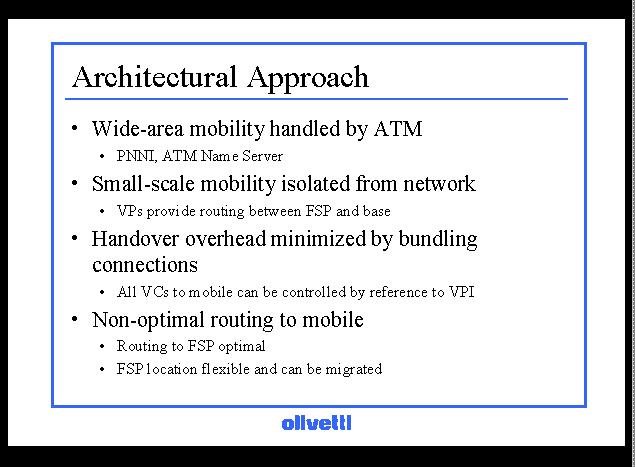 |

|

|

|

|
 |

|

|

|

|
The approach we have taken to solving some of the problems.
In the context of this system mobility is considered to be divided into small and wide area. Wide area mobility is the movement between organisations or buildings, small area mobility is that within a single building.
For the in-building systems we consider that there is a requirement that virtual circuits are maintained and applications continue to operate transparently as a mobile moves within a building, but as the mobile moves outside the building, travels it less likely that the in-building type of connectivity will be required, furthermore it is also probably not possible to provide this type of service in the wider area.
In any ATM system there must be some support for mobility. It should be possible for a device to be moved from one location to another, re-connected to the ATM infrastructure at a different point and be contactable by other ATM end-points in the network. We suggest that this type of support for low-speed, low-rate mobility will be provided by the ATM infrastructure.
Wide area mobility is therefor handled using standard ATM routing and addressing protocols..
Small-scale mobility, that between pico-cells within a building, is isolated from the wider area ATM network. All connections to and from a particular mobile are routed through a single switch while it remains in the same area. This switching poing is termed the fixed switching point for the mobile. The part of the connections between remote hosts and the mobile remain fixed as the mobile moves between pico-cells.
The intervening switches then route the message based on their VPI translation tables and do not need to run any PNNI routing.
The overhead of controlling handovers is minimised because all the virtual circuits to a particular mobile are routed through the FSP and control messages can refer to the set of connections to the mobile.
The approach implies that the routing of connections to the mobile will be non optimal as they are constrained to pass through the FSP. However, the routing from the remote host to the FSP is optimal, determined by PNNI, and the location of the FSP can be chosen for efficiency.